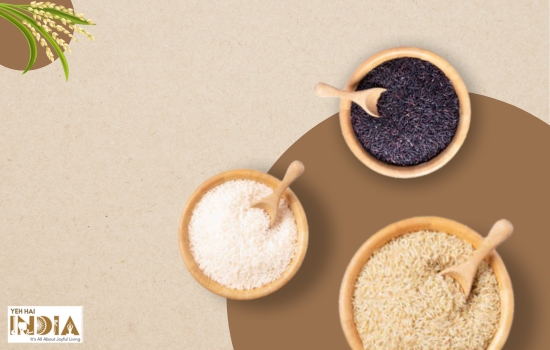Basmati rice is not just another ingredient in an Indian kitchen, it’s a feeling. It holds a special place in India’s rich culinary legacy. It has found its way into kitchens and cuisines all around the world, thanks to its unique aroma and diverse utility.
Basmati rice’s mouthwatering sensory characteristics make it a beloved household staple as well as a prized ingredient for chefs and home cooks.
What is Basmati Rice?

Basmati rice is famous for its distinct qualities, which make it popular for enriching every meal it adorns.
Colour: translucent, creamy white. Brown basmati rice is also available.
Appearance: large, unbroken grains that separate easily.
Aroma and flavour: a delectable nutty flavour and a fragrant scent.
These characteristics have given Basmati rice the title of “King of Rice,” and its popularity stretches well beyond its native areas.
Basmati Rice Nutritional Value
The nutritional profile of basmati rice makes it a healthy option for a range of diets.
Macronutrients
| Nutrient | Amount (per 100g cooked Basmati rice) |
|---|---|
| Calories | 121 kcal |
| Carbohydrates | 25.5 grams |
| Protein | 3.22 grams |
| Fat | 0.2 grams |
Vitamins:
- Thiamin (Vitamin B1): Necessary for energy metabolism and nerve function.
- Niacin (Vitamin B3): Aids in DNA repair and is essential for skin health.
- Folate (Vitamin B9): Required for cell division and DNA synthesis.
Minerals:
- Manganese: Essential for bone health and metabolism.
- Selenium: Important trace element with antioxidant effects.
- Phosphorus: Essential for bone health and cell function.
Potential Health Benefits of Basmati Rice
| Naturally low in fat. | Making it ideal for people on low-fat diets. |
| Contains complex carbs that give long-lasting energy, | making it a good choice for athletes and active people. |
| Low in sodium. | Good for people watching their salt consumption. |
| Gluten-free. | Suitable for anyone with celiac disease or gluten intolerance. |
| A good source of B vitamins such as thiamin, niacin, and folate. | These vitamins play important roles in energy metabolism and general health. |
Growth and processing of Basmati rice
| Stage | Description |
| Cultivation | Grown in the Indian subcontinent, requires well-drained soil and a warm climate. |
| Planting | Sown in nurseries and later transplanted during the monsoon season. |
| Harvesting | Hand-harvested when grains reach the desired maturity level to preserve aroma and long grains. |
| Drying | Rice is sun-dried to reduce moisture content, preventing fungal growth. |
| Milling | Processed in mills where the outer husk, bran layer, and germ are removed, leaving the endosperm, resulting in white Basmati rice. |
Applications of Basmati Rice

These applications demonstrate Basmati rice’s adaptability in a variety of cuisines and culinary creations. Due to its capacity to absorb flavours, it is a popular ingredient in a variety of recipes, ranging from savoury to sweet.
- Pilaf or Pulao
- Biryani
- Khichdi
- Plain Steamed Rice
- Rice Pudding (Kheer)
- Stir-Fried Rice
- Rice Salads
- Rice Flour
- Rice Bran Oil
- Rice Water
- Traditional Rituals
Basmati Rice Varieties

Each variety has its unique characteristics, making it a versatile choice for various culinary applications.
Traditional basmati (true basmati)
- It is slender and has aromatic grains that elongate upon cooking.
- Has a delicate, nutty aroma and flavor. Non-sticky, light, and fluffy texture.
- Ideal for biryani, pilaf, and plain steamed rice.
Pusa basmati
- It is a hybrid variety known for its extra-long grains and aromatic fragrance.
- It is quite versatile and used in a wide range of dishes.
Dehradun Basmati
- It is popular for its distinct fragrance and delicate flavour.
- Slightly shorter grains compared to traditional Basmati.
- Ideal for traditional Indian dishes.
Taraori Basmati
- It is known for its aromatic qualities and elongated grains.
- Has a sweet and nutty flavour.
- Commonly used for traditional North Indian rice dishes.
Basmati370
- One of the older Basmati varieties with slender, long grains and a pleasant aroma
- Ideal for classic Basmati dishes like biryani, pulao, and plain steamed rice.
Pusa 1121Basmati
- It is known for its extremely long grains and exquisite aroma. It’s often considered one of the finest Basmati varieties.
- Ideal for premium rice dishes like biryani.
Organic Basmati rice
- It has long and slender grains.
- Fluffy texture and easily separates on cooking.
- High in amylose but low glycemic index.
Brown Basmati rice
- It is one of the most nutritious options with a firm texture.
- Whole grain, which is minimally processed.
- Has an abundance of minerals, vitamins and fiber.
- The chewier consistency makes it ideal for stir-fries and salads.
Aromatic Basmati rice
- It is renowned for its several months of ageing process.
- Ideal for aromatic preparations like biryani and pulao.
Sella Basmati rice
- It is a parboiled variety.
- Before milling it undergoes a steam treatment to maintain a firm texture.
- Ideal for biryanis.
Parboiled Basmati rice
- It is partially parboiled.
- This technique is opted for maintaining the nutritional value of rice.
- Ideal for recipes that require a firm texture.
Premium Basmati rice
- It is amongst the top-quality rice with long grains.
- These are precisely handpicked.
- Has a gentle aroma and fluffy texture.
- Aged for several months to have a matured aroma and flavour.
- Ideal for dishes that need a light and delicate grain.
Each type of Basmati rice offers a unique culinary experience, and the choice depends on personal preferences and the specific dish being prepared. The fragrance, flavour, and texture of Basmati rice varieties add an exquisite touch to a wide range of recipes, making them a favourite in cuisines worldwide.
Basmati rice vs. other rice varieties
- Basmati rice has fewer calories than Jasmine, long-grain white, and short-grain white rice.
- The carbohydrate composition of basmati rice, jasmine rice, long-grain white rice, and short-grain white rice is comparable.
- The protein content of various rice cultivars is constant.
- Basmati rice has the same amount of dietary fibre as other rice varieties.
- All of these rice varieties are low in fat.
- The concentration of vitamins (Thiamin and Niacin) and minerals (Manganese, Selenium, and Phosphorus) is typically stable throughout rice cultivars.
While there may be minor changes in nutrient content, the decision between different rice kinds frequently comes down to texture, aroma, and flavour rather than substantial differences in nutritional value.
Each rice type may be appropriate for a number of culinary uses and personal preferences.
How To Cook Basmati Rice Perfectly?

- Rinse under cold water to remove excess starch; continue until the water is clear.
- Soak rice for about 30 minutes to have a better texture with reduced cooking time.
- Water-to-Rice Ratio: normally 1.5 to 2 cups of water for a single cup of rice, which can be adjusted as per the desired texture.
- Cook in a heavy-bottomed utensil that has a tight-fit lid. Boil water and add rice, followed by cooking at a low to medium flame. Usually, the preparation takes 15-20 minutes.
- Allow cooked rice to rest for a while to obtain a fluffy texture.
Basmati Rice Storage and Shelf Life
| Aspect | Description |
| Storage | Keep Basmati rice in an airtight container to prevent moisture and pests. Store it in a cool, dry place away from direct sunlight. |
| Shelf Life | White basmati rice can have a shelf life of up to 2 years if stored properly. Brown basmati rice, with its bran layer, has a shorter shelf life (6 months to a year) due to natural oils. |
| Precautions | Ensure the storage container is clean and dry. Avoid storing near strong-smelling items to prevent the rice from absorbing odours. Use dry neem leaves or cloves tied in a cotton cloth and keep them in containers to prevent insects from attacking. |
Note: The above information given is for uncooked rice.
Summary
Basmati rice, originating in Asia, is a beloved household staple and a prized ingredient for chefs and home cooks. It’s unique aroma and diverse utility make it a beloved ingredient in various cuisines. Basmati rice is low in fat, contains complex carbohydrates, is gluten-free, and is a good source of B vitamins.
It is used in various dishes, such as pilaf, biryani, khichdi, plain steamed rice, rice pudding, stir-fried rice, rice salads, rice flour, rice bran oil, and rice water. Proper storage and shelf life are essential for its longevity.
Recommended Article: From Bran to Brilliance: Rice Bran Oil Nutrition, Health Benefits and Considerations
Sources
- Nutritional value of different types of rice by Mehmood, T. et al. (2014). Published in International Journal of Food Science & Nutrition, 53(2), 143-164.
- Basmati rice: A review of its nutritional properties, health benefits, and culinary applications by Chen, H., & Hu, L. (2018). Published in Food & Nutrition Research, 62(1), 1299417.










